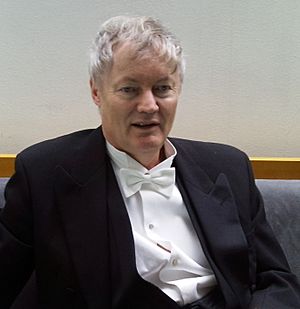Michael Grätzel facts for kids
Quick facts for kids
Michael Grätzel
|
|
|---|---|
 |
|
| Born | 11 May 1944 Dorfchemnitz, Saxony, Germany
|
| Nationality | Swiss |
| Alma mater | Free University of Berlin Technische Universität Berlin |
| Known for | Dye-sensitized solar cells |
| Awards | Harvey Prize (2007) Balzan Prize (2009) Millennium Technology Prize (2010) Albert Einstein World Award of Science (2012) Marcel Benoist Prize (2013) King Faisal International Prize (2015) Global Energy Prize (2017) |
| Scientific career | |
| Fields | photochemistry |
| Institutions | Free University of Berlin École Polytechnique Fédérale de Lausanne |
| Thesis | Pulsradiolytische Untersuchung kurzlebiger Stickstoff-Sauerstoffverbindungen in wässriger Lösung (1971) |
| Doctoral advisor | Arnim Henglein |
| Other academic advisors | J. Kerry Thomas |
| Notable students | Henry Snaith (postdoc) |
Michael Grätzel is a famous scientist born on May 11, 1944, in Dorfchemnitz, Germany. He is a professor in Switzerland at the École Polytechnique Fédérale de Lausanne. There, he leads a special lab that studies light and how it interacts with materials.
Professor Grätzel is known for his amazing work on how energy and tiny particles called electrons move in special materials. He helped create a new type of solar cell called the Grätzel cell in 1988. Many people call him the "father of artificial photosynthesis." This means he found ways to make energy like plants do, but in a lab!
He has written over 1000 scientific papers and two books. He also holds more than 80 patents for his inventions. He has been a visiting professor at many universities around the world.
Contents
Michael Grätzel's Journey in Science
His Education and Early Career
Michael Grätzel finished his first degree in 1968 at the Free University of Berlin. In 1971, he earned his PhD in natural science from Technische Universität Berlin. He continued his studies and became a professor of physical chemistry in 1976.
Since 1977, he has been a professor at the École Polytechnique Fédérale de Lausanne in Lausanne, Switzerland. He leads the Laboratory of Photonics and Interfaces there. Before this, he worked at many other important research centers.
The Invention of Grätzel Cells
In 1991, Professor Grätzel published a very important discovery in Nature magazine. He introduced a new kind of solar cell. These cells use tiny particles of a special material covered with a colorful dye. These cells were so important that they were named after him: Grätzel cells.
Professor Grätzel has received 10 honorary doctorates from universities in Asia and Europe. He has also won many top science and engineering awards. These include the Millennium Technology Grand Prix and the Faraday Medal.
Memberships and Honors
Michael Grätzel is a member of many important scientific groups. These include the Swiss Chemical Society and the Max Planck Society. He is also an honorary member of the Israeli Chemical Society and the Bulgarian Academy of Science. He is an honorary fellow of the Royal Society of Chemistry.
What Are Grätzel Cells?
Professor Grätzel is one of the inventors of dye-sensitized solar cells, also known as Grätzel cells. These are a new kind of solar cell. They work in a way that is similar to how plants use sunlight to make energy, a process called photosynthesis.
Awards and Recognition
Professor Grätzel's work is highly respected around the world. His scientific papers have been mentioned by other scientists over 467,000 times. This makes him one of the most cited chemists globally.
He has often visited the National Renewable Energy Laboratory (NREL) in Golden, Colorado. He was also a fellow of the Japanese Society for the Promotion of Science. In 2009, he was named an honorary professor by the Chinese Academy of Science.
Professor Grätzel has received many awards for his groundbreaking work. Some of these include:
- The Millennium 2000 European innovation prize.
- The 2001 Faraday Medal from the British Royal Society.
- The 2007 Harvey Prize for his research on energy and electron transfer.
- The 2009 Balzan Prize for new materials science.
- The 2010 Millennium Technology Prize for developing dye-sensitized solar cells. He received 800,000 euros for this award in Helsinki, Finland.
- The 2012 Albert Einstein World Award of Science.
- The 2013 Marcel Benoist Prize.
- The 2015 King Faisal International Prize in Chemistry.
- The 2017 Global Energy Prize for his work on low-cost solar cells.
- The 2020 BBVA Foundation Frontiers of Knowledge Award.
He also holds honorary doctorates from universities like Uppsala University in Sweden.
Learn More
- Grätzel cell (Dye-sensitized solar cell)
- Photoelectrochemical cell
- Perovskite solar cell
See also
 In Spanish: Michael Grätzel para niños
In Spanish: Michael Grätzel para niños

